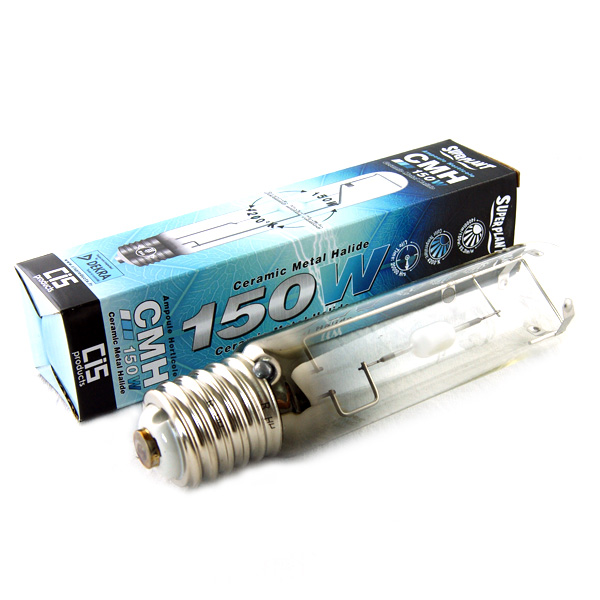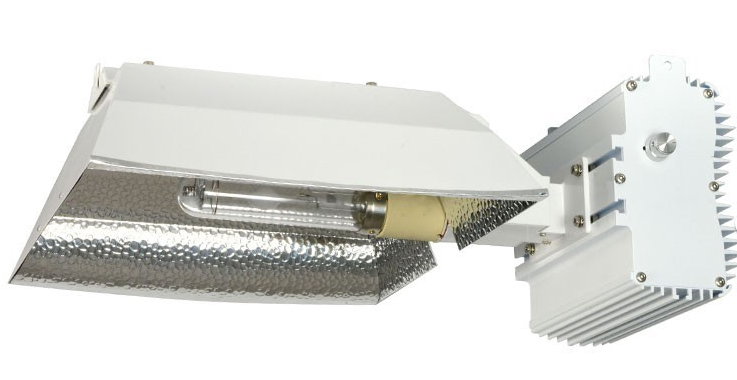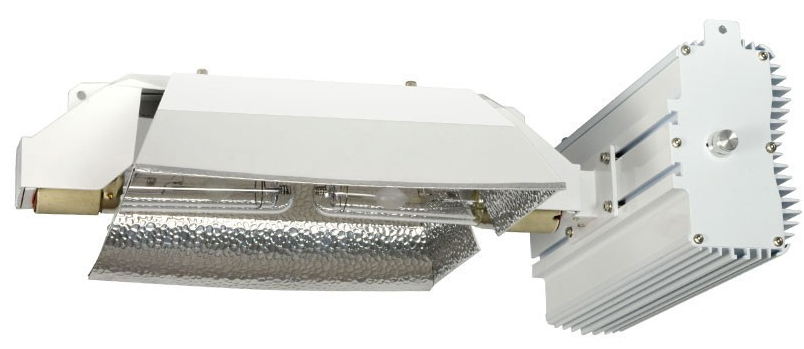CMH (Ceramic Metal Halide)
What is a CMH lamp?
The CMH lamp is a similar source to MH lamps (metal halide), however CMH bulbs are up to 50% more efficient in lumens and 10 to 20% more efficient in Umol/m² PPFD than MH lamps mH bulbs.
The cMH lamps are often used in store lighting, street lighting, and especially in agriculture and intensive horticulture of plants of all kinds, the CMH is a technology tested by INRA for the indoor plant growing.
The ceramic metal halide is a variant of the metal halide lamp which is also a variant of the old and first high pressure technology (the first mercury vapor lamp created).
A CMH lamp uses ceramic instead of the quartz used for the traditional MH lamp.
Ceramic arc tubes allow for much higher temperatures than metal arc tubes, and for most manufacturers, this simply translates into better efficacy of CMH lamps compared to MH lamps, better color rendering, better color stability, and a lifetime of up to 24,000 hours of illumination
CDM or CMH lamps use one-fifth of the comparable power when compared to incandescent bulbs for the same light output of about (80-120 lm/W) and this CMH lamp maintains color stability better than most other gas discharge lamps. Like other high intensity discharge lamps with high performance, these lamps need a suitable rating of magnetic ballast orelectronic ballast to work smoothly!
We guide you to CMH ceramic metal halide lights
The industry is changing, and competition between producers of CMH lamp has become fierce. If you always want to grow better, you need to stay up to date on the latest horticultural lighting technology. This means becoming more familiar with the latest innovation in metal halide ceramics (MHC) lighting with the led. Ceramic metal halides, also known as light emitting ceramics, are the latest inHID lighting. They bring many advantages and only a few disadvantages.
What are CMH Grow Lights?
CMH metal halide grow lights are made with an arc tube made of a ceramic composite instead of quartz or PCA. This allows the tube to reach a higher temperature. To achieve a lower operating temperature in HID lamps made with quartz or PCA, a combination of gases must be used that may not produce the optimal light spectrum for photosynthesis.
The higher operating temperature of the ceramic tube allows for an ideal mixture of gases. This creates a fuller spectrum of light that increases the growth, overall health and yield of your plants. A special ballast is required for ceramic metal halides. Not just any digital ballast will do. CMH lamps require a low frequency, which makes high frequency digital ballasts incompatible.
Depending on the quality of the system and where you shop, the full range of CMH setups varies from €200 to €1,100 with an average price of €550. Most setups work with a 315W lamp, but there are a few units that have two lamps for a total of 630W. The lamps themselves cost between 80 and 100 €. The lamps come in two versions: the 3100K (full spectrum) and the 4200K (blue spectrum). The manufacturers claim that you only need to replace your lamps every two years.
The advantages
Why buy a CMH bulb or lamp?
The money you save on your electric bill is the #1 reason to switch to CMH (grow the light) technology. Although the initial system cost is more expensive than other HID systems on the market, CMH systems will save you money in the long run. Some jurisdictions even recognize them as energy efficient lighting systems and offer incentives to offset the initial cost.
Some suppliers claim that the CMH 315W equivalent to a 1,000W HPS lamp in terms of efficiency. Others have reported that you need two 315W CMH lamps to produce the same output as a 1,000W HPS. The different reports probably have to do with other things in the garden and the skill level of the gardener, and the truth is probably somewhere in the middle. In any case, the general consensus is that your output per watt is higher with ceramic metal halides, and you're going to spend much less on electricity to power your lights.
These lights also have a low heat output because of their low wattage. One watt of a grow light creates about 4 BTUs of heat that needs to be cooled. Let's say you have a small room with four 1000 W HPS grow lights. Your four lights alone create 16,000 BTUs of heat that need cooling. If you swap those lights for four 630-W units, which match, if not exceed, your current output, you will only create 10,000 BTUs of heat. Your air conditioner won't have to run as often, and you'll see savings on your electric bill. CMHs low heat output makes it an ideal choice for small growing spaces, such as closets and grow tents.
More and more benefits with the CMH lamp..
Another advantage is that, with the ballasts needed to run them, you won't have to deal with the electromagnetic interference (EMI) issues that many farmers experience with digital ballasts. High levels of EMI from digital ballasts are known to interfere with cell phone service, radio, Wi-Fi and cable television, and the Federal Communications Commission issues citations to those who violate EMI emission standards.
A final advantage of CMH bulbs is their superior light quality compared to other HID lamps, which is due to a few factors. First, they have a broader spectrum than other HID lamps - a result of the almost perfect, unique combination of salts, halides and gases used in the arc tube.
This mixture creates a spectrum close to that of the sun and emits a dazzling white light. In fact, the color rendering index (CRI) for ceramic lamps ranges from 90 to 92. To give you some perspective, the CRI of the sun is 100. HPS lamps range from 20-30, and metal halides range from 60-65. The closer the CRI is to 100, the closer the spectrum is to the sun.
In terms of light quality, CMH ceramics include ultraviolet and infrared rays in their spectrum, which plants love. The higher amounts of UV light create stronger, more woody stems and better structure in your plants. This means that the growth and vigor of your plants will be unmatched, especially in the vegetative stage. Because of the incredible growth that CMH lights produce, growers have reported great success when using silica supplements with these lights.
Silica aids in cell division and creates stronger cell walls, making leaves, stems and branches significantly stronger and better able to withstand the weight of fruit. Plus, pests don't like woody stems because they are too hard to chew. Compare it to eating a tender, juicy steak versus eating a cooked, dry steak.
Which one do you honestly prefer?
Finally, CMH ballasts use square wave technology. When you look at the graph on the back of your bulb box, notice the high peaks and low dips. The high peaks are an indicator of the energy coming out of the bulb. The low dips indicate light trying to travel to the next peak. You can see this with your own eyes when you take pictures and videos of your grow room. With most HID lights, you will see bands of light in your photos.
The bands of light are the peaks in the graph, and the spaces between them indicate the dips. With square wave technology, there are fewer dips. A more stable beam of light is produced, which means your plants receive more light throughout their life.
The disadvantages of CMH lamps
There are two main drawbacks to the CMH lamp, the first has already been mentioned, which is the initial cost. If you are like most growers, you probably took the most affordable route to setting up your garden. However, as your knowledge and experience increases over time, you may see the value of upgrading certain components in your grow room. Quality lighting offers dividends to the crop. This, coupled with long-term energy savings, lowers the initial cost of the CMH lamp for many growers.
The other disadvantage is that growers have to be careful in the grow room when the lights are on. Many MHC grow lights have warnings from the manufacturers that suggest growers should not be around the lights for more than a few minutes, unless proper shielding is used or other protection is employed.
That's because if the outer shell of the lamp is broken or punctured, you run the risk of severe skin burns and eye inflammation from the shortwave UV rays. This is only a potential drawback if you like to work in your garden for long periods with the lights on. Alternatively, you can work during the dark cycle.
Did you know?
A green LED flashlight can provide you with light during the night as the green light will not disrupt the natural rhythms of the plants. Another option is to use a reflector with a lens covering the bulb, but the disadvantage of this is the reduced light for the plants. It is important to note that, overall, CMH lamps are safe, but it is always better to be safe than to take risks. So protect your eyes if the product is broken.
The bottom line with your CMH lights?
You should consider switching to ceramic metal halide to increase your yields. Then you'll be a happy grower with your own harvest coming in.
Who invented the CMH lamp?
The THORN Group was the first CMH bulb and lamp manufacturer since 1981 to invent this unique ceramic metal halide technology that provides unique performance.
Who was the first distributor in the world?
In 1994 philips became the first official distributor of the first CMH bulbs on the international territory, sold and ranked among the best horticultural lighting.
Translation of CMH
CMH = Ceramic Metal Halide
What models of CMH can be found in the market?
Discover the different ranges of CMH lamps at culture indoor, your online growshop for indoor gardening and intensive plant growing.
At Culture Indoor there are models 150W CMH and 250W CMH (attention only compatible with magnetic ballasts) of the renowned brand SUPERPLANT lightingthe CMH technology is accessible for your indoor cultures, unique CMH lamps adaptable on your1st price lamps kit.
You can also discover the brand Calitek and its revolutionary and innovative horticultural lighting systems. Equipped with ballast, reflector and CMH 315 or 630W bulb, for growth or flowering.
These hybrid bulbs are equipped with an MH and HPS system. Their wide light spectrum is better absorbed by the plant. It is used in growth and flowering, with its 30% more blue.
Discover the CMH 315W double ended lamps, a unique technology.
 Also available in flowering version.
Also available in flowering version.
Find all CMH models at culture indoor, MAXIGROW CMH 315W, DIMLUX 315W, MAXIGROW CMH 630W, CMH 150W SUPERPLANT E40, CMH 250w superplant E40, CMH bulbs or philips CMD at the best prices in our rays of CMH bulbs, CMH lamps kit.
Culture indoor informs you about all the technologies for your plants.
What is the difference between metal halide (MH) VS ceramic metal halide (CMH) ?
*MH: Metal Halide bulb. Its spectrum is ideal for vegetative growth.
*CMH: Ceramic Metal Halide bulb. Its technology has the same qualities as the MH bulb except that it lasts longer, heats less and lights more.
The technical terms in horticultural lighting will no longer be a secret for you thanks to our lexicon and our lighting section*.




